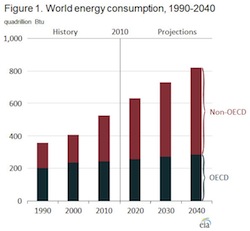According to the International Energy Outlook 2013 (IEO2013) report released by the U.S. Energy Information Administration (EIA), over the next three decades, world energy consumption is projected to increase by 56 percent. This will be driven by growth in the developing world. Clean-fuel technology is also playing an important role in the outlook, with renewable energy and nuclear power expected to grow faster than fossil fuels over the forecast period.
 “Rising prosperity in China and India is a major factor in the outlook for global energy demand. These two countries combined account for half the world’s total increase in energy use through 2040,” said EIA Administrator Adam Sieminski. “This will have a profound effect on the development of world energy markets.
“Rising prosperity in China and India is a major factor in the outlook for global energy demand. These two countries combined account for half the world’s total increase in energy use through 2040,” said EIA Administrator Adam Sieminski. “This will have a profound effect on the development of world energy markets.
IEO2013 presents updated projections for world energy markets through 2040. The IEO2013 Reference case projection does not incorporate prospective legislation or policies that might affect energy markets.
Key findings include:
- World energy consumption increases from 524 quadrillion British thermal units (Btu) in 2010 to 820 quadrillion Btu in 2040. The increase in world energy use is largely in the developing world, where growth is driven by strong, long-term economic growth. Half of the total world increase in energy consumption is attributed to China and India.
- IEO2013 projects increased world consumption of energy from all fuel sources through 2040. Fossil fuels are expected to continue supplying much of the energy used worldwide. Although petroleum and other liquids remain the largest source of energy, the liquid fuels share of world marketed energy consumption falls from 34 percent in 2010 to 28 percent in 2040. Renewable energy and nuclear power are the world’s fastest-growing energy sources, each increasing by 2.5 percent per year; however, fossil fuels continue to supply almost 80 percent of world energy use through 2040.
- Natural gas is the fastest growing fossil fuel in the outlook. Global natural gas consumption grows by 1.7 percent per year. Increasing supplies of tight gas, shale gas, and coalbed methane support growth in projected worldwide gas use. Coal grows faster than liquid fuels consumption until after 2030, due to increases in China’s consumption of coal and tepid growth in liquid fuels demand attributed to (1) slow growth in Organization for Economic Cooperation and Development (OECD) member countries, and (2) high sustained oil prices.
The report also finds that given current policies and regulations limiting fossil fuel use, worldwide energy-related carbon dioxide emissions rise from about 31 billion metric tons in 2010 to 36 billion metric tons in 2020 and then to 45 billion metric tons in 2040, a 46 percent increase over the 30-year span.

